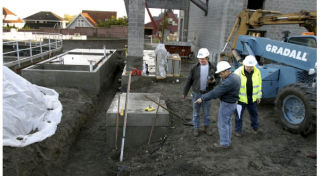If you walk into the residential area east of the Ferry Terminal you might catch a faint whiff of the city’s largest utility project.
The development of the Waste Water Treatment Plant on Hawley Way has been a saga of patchwork and penny-pinching to meet state and city regulations. However, some City Council members want to reexamine its design and possibly upgrade the facility into a Class A exemplar of Puget Sound sewage treatment.
That could mean revising a current construction contract and increasing the overall costs of the facility.
Starting in 1978 with the help of a state mandate and funding, the WWTP was created to clean up the Winslow sewage discharge.
Today, many of those 30-year-old facilities remain, rusted and in violation of state regulations.
As early as 2002, it was apparent that the facility needed to be overhauled, but just how to go about it diverged greatly. The council settled on a $9.5 million upgrade in 2005 that would create Class B discharge and fulfill the requirements set forth by the state.
Some current council members believe the technology is now available to upgrade the facility to create Class A discharge.
“The technology has improved greatly,” council member Kjell Stoknes said. “If the 2005 council knew they could upgrade to Class A discharge for about $1 million, I’m sure they would have jumped at the chance.”
“It would be unfortunate to spend $14 million at the end of this process and end up with a second-rate system,” said council member Kim Brackett who is backing a Class A upgrade for environmental reasons.
However, the plant is currently under contract to complete the design approved in 2005. It’s not know if it’s possible, or how much it would cost, to halt the project and upgrade to a Class A facility. The membranes needed to create Class A discharge are estimated between $1 and $2 million.
“If we went with Class A we could pump (the discharge) up to other areas to water golf courses or recharge the island’s aquifers; there are all kinds of reasons to go with that alternative,” Public Works Director Randy Witt said.
“The issue is you have to build more infrastructure to do it and there is a great expense in that. Then who pays for that?”
Additional costs are not something many council members want to discuss so deep into construction on the Class B facility.
“I am hearing a lot of people talking about rates. I would like to understand the impact to the ratepayers as a first step…we owe some transparency,” Stoknes said. “But it would be nice to know what our options are for Class A, and make some decisions.”
The council requested a rate study last summer and it’s expected to be completed early next year.
The cost of the WWTP construction is set at about $9.2 million. But a host of related costs and patch jobs has pushed the project over $14 million. Everything from planning, design, bidding, and disinfection and pumping upgrades since 2002 are all calculated into the total project cost, which tops out at $14.7 million.
“I don’t think the project’s costs are out of line with the work we are doing,” Witt said. “It is a necessary part of owning and operating a plant that meets our regulatory requirements. Where the costs become high is for ratepayers, because we have a smaller customer base, and we’re hobbled by that.”
If there are no further design changes, the Waste Water Treatment Plant is expected to be completed in late February 2010.



